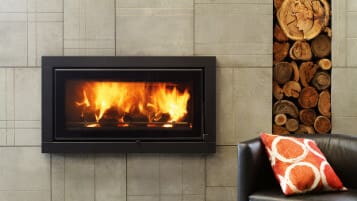what you can do so you are burning wood safely
Recently, wood fires have come under scrutiny as the NSW cabinet forms their 10-year Clean Air Strategy, aiming to reduce public exposure to residential wood smoke.
The dialogue regarding wood heating and its contribution to indoor and outdoor pollution has remained constant over the years, however, it is important to understand that wood heating is an environmentally sustainable and healthy option if conducted in the right way.
Air quality, particularly in urban areas is affected by several factors such as vehicle exhaust and brake-dust emissions, industrial processes, household solvents and the burning of solid fuels for heating. It’s worth bearing in mind though, that pollution attributed to the burning of solid fuels for heating is taking into account open fires, which are far more polluting than stoves or glass fronted solid fuel appliances.
The main factors to ensure wood heating remains a safe heating option consist of the following:
- The type of wood heater you are choosing
- If your wood heater is installed correctly
- The type of fuel you are burning and how you are burning it
- Whether you are regularly servicing your wood heater
Below, we discover why these factors matter and what you can do so you are burning wood safely.
Choose the correct wood heater
The design and technology that goes into creating today’s wood heaters is a far cry from those of yesteryear. In 2015 emissions were reduced from 4.0g/kg to 2.5g/kg. Then in 2019 they were reduced further to 1.5g/kg. The Australian Standard is one of the strictest emissions standards in the world.
Newer appliances feature next generation combustion technology and advanced engineering that reduces smoke emissions, so you can still enjoy your woodfire without harmful pollution.
AHHA has introduced a robust certification procedure to ensure all wood heater models sold comply with the current Australian and New Zealand Standards. Certified wood heaters are a clean and efficient form of heating, so ensure you purchase a certified wood heater from an AHHA Expert Local Retailer which meets all the required standards. Also make sure that you choose the right type of wood heater for your home; see our page on types of wood heaters to explore which type is most suitable for you.
Make sure your wood heater is installed correctly
Most air pollution is produced during the fire start up and when a fire is poorly managed (for example, when airflow to the heater is reduced, allowing wood to smoulder.) Improperly installed heaters or clogged chimneys may increase the amount of air pollution inside the home and increase the likelihood of health effects.
Heaters that conform to Australian Standard 4013 and are installed properly, operated correctly and adequately maintained are less polluting and less likely to have adverse health effects.
State and local councils may also have different requirements about who can install the unit, or the certification required. Check the statutory requirements in your area before starting any work.
For everything you need to know about installing a wood heater, click here.
To ensure your heater is installed correctly and to get the best advice, choose your local AHHA member here.
Use the right fuel and burn it correctly
The amount of particulate matter caused by burning solid fuels varies dramatically depending on what and how it is burnt. It is crucial that only good quality solid fuels such as dry logs or authorised smokeless mineral fuels are burnt.
Burning the right fuel is one of the most important steps to ensure you are not producing harmful pollution. Burn only dry wood with no more than 20 % moisture content. If you are buying logs, place your orders early with a reputable fuel merchant who is preferably a member of The Australian Home Heating Association to be sure of what you are buying or collecting in firewood.
For the best results, always use the type of fuel recommended by the manufacturer. If your heater meets the national emission standard, it will have a compliance plate which specifies the correct fuel to use.
See our full list of tips on fuelling your fire here.
Regular servicing is important
You should also have your wood heater serviced regularly to ensure it continues to function correctly and does not produce unhealthy smoke.
Follow the manufacturer’s instructions on how to light and fuel your heater, so you can achieve maximum heating efficiency without burning excess wood.
Ideally have your chimney swept at least once a year. Not only will this ensure your stove is burning correctly, but it will also help to prevent chimney fires. We have a range of AHHA members who are experts in wood heating maintenance. You can find a trusted and local AHHA provider here.
For our full list of tips on maintaining your wood heater, click here.
The overall message regarding wood heating is that it’s all about having the right appliance, the right fuel and then burning it in the right way. This includes replacing old appliances with certified, newer appliances, properly maintaining your wood heater, and using only dry, well-seasoned wood, so everyone can enjoy the true magnificence of wood heating.



